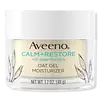Aveeno Face Calm and Restore Re-Hydrating Night Cream Versus Aveeno Calm + Restore Oat Gel Moisturizer
What's inside
What's inside
 Key Ingredients
Key Ingredients

 Benefits
Benefits

 Concerns
Concerns

 Ingredients Side-by-side
Ingredients Side-by-side

Water
Skin ConditioningIsopropyl Palmitate
EmollientGlycerin
HumectantCetyl Alcohol
EmollientGlyceryl Stearate Se
EmulsifyingAvena Sativa Kernel Flour
AbrasiveButyrospermum Parkii Butter
Skin ConditioningChrysanthemum Parthenium Flower/Leaf/Stem Juice
AntioxidantCaprylyl Glycol
EmollientCopper Gluconate
Skin ConditioningTropolone
Skin Conditioning1,2-Hexanediol
Skin ConditioningMagnesium Aspartate
Skin ConditioningZinc Gluconate
Skin ConditioningPentylene Glycol
Skin ConditioningHydrogenated Palm Glycerides
EmollientSodium Polyacrylate
AbsorbentPotassium Cetyl Phosphate
EmulsifyingCarbomer
Emulsion StabilisingSodium Hydroxide
BufferingCitric Acid
BufferingSodium Metabisulfite
AntioxidantPhenoxyethanol
PreservativePotassium Sorbate
PreservativeSodium Benzoate
MaskingWater, Isopropyl Palmitate, Glycerin, Cetyl Alcohol, Glyceryl Stearate Se, Avena Sativa Kernel Flour, Butyrospermum Parkii Butter, Chrysanthemum Parthenium Flower/Leaf/Stem Juice, Caprylyl Glycol, Copper Gluconate, Tropolone, 1,2-Hexanediol, Magnesium Aspartate, Zinc Gluconate, Pentylene Glycol, Hydrogenated Palm Glycerides, Sodium Polyacrylate, Potassium Cetyl Phosphate, Carbomer, Sodium Hydroxide, Citric Acid, Sodium Metabisulfite, Phenoxyethanol, Potassium Sorbate, Sodium Benzoate
Water
Skin ConditioningGlycerin
HumectantDimethicone
EmollientCetearyl Olivate
Avena Sativa Kernel Flour
AbrasiveSorbitan Olivate
EmulsifyingPolyacrylamide
Synthetic Beeswax
Emulsion StabilisingPhenoxyethanol
PreservativeC13-14 Isoparaffin
EmollientButylene Glycol
HumectantDimethicone Crosspolymer
Emulsion StabilisingPanthenol
Skin ConditioningChlorphenesin
AntimicrobialDimethiconol
EmollientCarbomer
Emulsion StabilisingLaureth-7
EmulsifyingChrysanthemum Parthenium Flower/Leaf/Stem Juice
AntioxidantEthylhexylglycerin
Skin ConditioningSodium Hydroxide
BufferingAvena Sativa Kernel Extract
AbrasiveCentella Asiatica Extract
CleansingWater, Glycerin, Dimethicone, Cetearyl Olivate, Avena Sativa Kernel Flour, Sorbitan Olivate, Polyacrylamide, Synthetic Beeswax, Phenoxyethanol, C13-14 Isoparaffin, Butylene Glycol, Dimethicone Crosspolymer, Panthenol, Chlorphenesin, Dimethiconol, Carbomer, Laureth-7, Chrysanthemum Parthenium Flower/Leaf/Stem Juice, Ethylhexylglycerin, Sodium Hydroxide, Avena Sativa Kernel Extract, Centella Asiatica Extract
 Reviews
Reviews

Ingredients Explained
These ingredients are found in both products.
Ingredients higher up in an ingredient list are typically present in a larger amount.
Oatmeal flour is created by grinding down the kernels of oats. Oatmeal helps sooth, hydrate, and protect the skin.
Oatmeal kernel flour has abrasive, or exfoliating, properties.
Learn all about the skin benefits of colloidal oatmeal here.
Learn more about Avena Sativa Kernel FlourCarbomer is a polymer of acrylic acid. Its main role is to create a gel consistency.
A high amount of carbomer can cause pilling or balling up of products. Don't worry, most products contain 1% or less of carbomer.
Chrysanthemum Parthenium Flower/Leaf/Stem Juice is an antioxidant.
Glycerin is already naturally found in your skin. It helps moisturize and protect your skin.
A study from 2016 found glycerin to be more effective as a humectant than AHAs and hyaluronic acid.
As a humectant, it helps the skin stay hydrated by pulling moisture to your skin. The low molecular weight of glycerin allows it to pull moisture into the deeper layers of your skin.
Hydrated skin improves your skin barrier; Your skin barrier helps protect against irritants and bacteria.
Glycerin has also been found to have antimicrobial and antiviral properties. Due to these properties, glycerin is often used in wound and burn treatments.
In cosmetics, glycerin is usually derived from plants such as soybean or palm. However, it can also be sourced from animals, such as tallow or animal fat.
This ingredient is organic, colorless, odorless, and non-toxic.
Glycerin is the name for this ingredient in American English. British English uses Glycerol/Glycerine.
Learn more about GlycerinPhenoxyethanol is a preservative that has germicide, antimicrobial, and aromatic properties. Studies show that phenoxyethanol can prevent microbial growth. By itself, it has a scent that is similar to that of a rose.
It's often used in formulations along with Caprylyl Glycol to preserve the shelf life of products.
Sodium Hydroxide is also known as lye or caustic soda. It is used to adjust the pH of products; many ingredients require a specific pH to be effective.
In small amounts, sodium hydroxide is considered safe to use. However, large amounts may cause chemical burns due to its high alkaline.
Your skin has a natural pH and acid mantle. This acid mantle helps prevent harmful bacteria from breaking through. The acid mantle also helps keep your skin hydrated.
"Alkaline" refers to a high pH level. A low pH level would be considered acidic.
Learn more about Sodium HydroxideWater. It's the most common cosmetic ingredient of all. You'll usually see it at the top of ingredient lists, meaning that it makes up the largest part of the product.
So why is it so popular? Water most often acts as a solvent - this means that it helps dissolve other ingredients into the formulation.
You'll also recognize water as that liquid we all need to stay alive. If you see this, drink a glass of water. Stay hydrated!
Learn more about Water